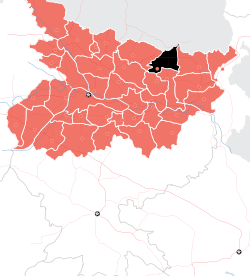It has a relatively small proportion of its net sown area unirrigated, indicating poor irrigation demand. Overall, water availability for irrigation in the district (based on ground water development and long-term trends of water level decline) is within the safe limit, enhancing long-term sustainability of solar pumps. It has a relatively low penetration of banks in rural and semi-rural areas, impeding access to institutional credit for farmers. There is a comparatively high level of farm mechanization in the district, implying a positive outlook towards progressive technologies amongst the farmers. The district has a relatively high proportion of small and marginal farmers. The district appears in the group of districts, which are (very) highly vulnerable towards climate change, as per an index constructed by CRIDA.
Deployment Approaches
| Approaches | Feasibility |
|---|---|
| Individually owned off-grid solar pumps | Limited Suitability |
| Solarisation of feeders | Limited Suitability |
| Solar based water as a service | Limited Suitability |
| Promote 1 HP and sub-HP pumps | Limited Suitability |
| Solarisation of individual grid-connected pumps | Limited suitability |
Individually owned off-grid solar pumps
Limited Suitability
The district has ground water available within the safe limit and a comparatively high concentration of diesel pump users. However, low crop revenue per holding, and the relatively low disbursement of institutional credit would make it difficult to promote the private ownership of solar pumps here without significant government subsidy support.
| Parameter | Value | Percentile |
|---|---|---|
| Number of cultivators reporting use of diesel pumps | 230,383 | 96 |
| Water Availability Index | 1 | 100 |
| Crop revenue per holding (INR) | 21,659 | 12 |
| Medium and long term institutional credit disbursed in a year (in INR Crore) | 0 | 0 |
Solarisation of feeders
Limited Suitability
The district has a comparatively high extent of feeder segregation, and its DISCOM incurs a high cost for supplying power. But, a relatively low penetration of electric pumps means that solarisation of the feeders would not help in increasing the deployment of solar for irrigation.
| Parameter | Value | Percentile |
|---|---|---|
| Actual cost of power supply (INR/kWh) | 6.03 | 51 |
| Extent of feeder segregation | ||
| Proportion of cultivators reporting use of electric pumps | 0% | 0 |
Solar based water as a service
Limited Suitability
Groundwater availability in the district is within safe limit and the concentration of small and marginal farmers is comparatively high, but the proportion of unirrigated area is relatively low. A solar-based water service will have to compete with existing sources of irrigation.
| Parameter | Value | Percentile |
|---|---|---|
| Water Availability Index | 1 | 100 |
| Proportion of small and marginal cultivators | 96% | 84 |
| Unirrigated net sown area as a share of total net sown area | 33% | 29 |
Promote 1 HP and sub-HP pumps
Limited Suitability
The district has a relatively high proportion of horticulture crops under gross cropped area, high concentration of marginal farmers and groundwater availability within the safe limit, but disbursement of institutional credit to marginal farmers is comparatively low. Greater support, either through subsidies or credit, would be required to enable marginal farmers to adopt solar pumps.
| Parameter | Value | Percentile |
|---|---|---|
| Area under horticulture crops as a share of gross cropped area | 7% | 54 |
| Water Availability Index | 1 | 100 |
| Proportion of marginal cultivators | 89% | 90 |
| Medium and long term institutional credit disbursed in a year (in INR Crore) | 0 | 0 |
Solarisation of individual grid-connected pumps
Limited suitability
The district has a comparatively high extent of feeder segregation, groundwater available within the safe limits and power supply to its agriculture consumers is heavily subsidised. But, a relatively low penetration of electric pumps means that solarisation of individual grid-connected pumps would not help in increasing the deployment of solar for irrigation.
| Parameter | Value | Percentile |
|---|---|---|
| Water Availability Index | 1 | 100 |
| Actual cost of power supply (INR/kWh) | 6.03 | 51 |
| Extent of feeder segregation |
Leveraging Solar Pumps to Promote Policy Objectives
If you are deploying solar pumps in this district then you can further these policy objectives.
National Mission on Oilseeds and Oil Palm (NMOOP)
The relatively low share of oilseeds and oil palm crops under gross sown area in the district makes it a suitable candidate for promoting NMOOP. Solar pumps could meet irrigation needs for these crops and help farmers diversify their yields beyond cereals.
| Parameter | Value | Percentile |
|---|---|---|
| Area under oilseeds as a share of total cropped area | 37 |
Climate Resilient Farming for Small Farms
Given the high concentration of small and marginal farmers—the most vulnerable group to climate change—and a high score on climate change vulnerability index provided by CRIDA*, the district is suitable for promoting climate resilient farming for small-sized farms. Solar pumps would assist in the same through low-carbon agriculture.
| Parameter | Value | Percentile |
|---|---|---|
| Proportion of small and marginal cultivators | 96% | 84 |
| Score on Climate Change Vulnerability Index | 0.6 | 89 |


